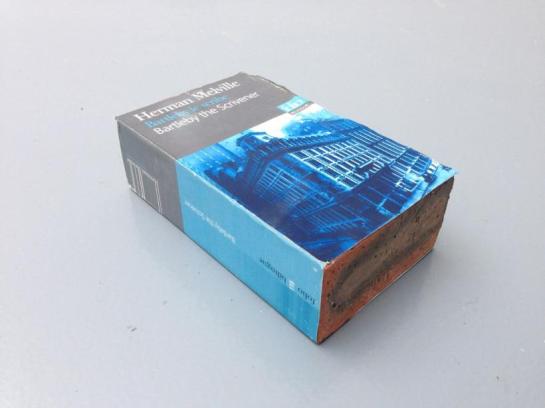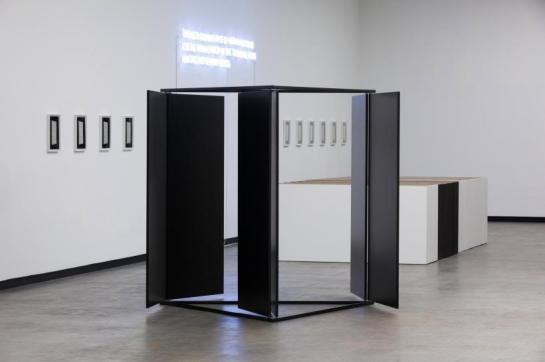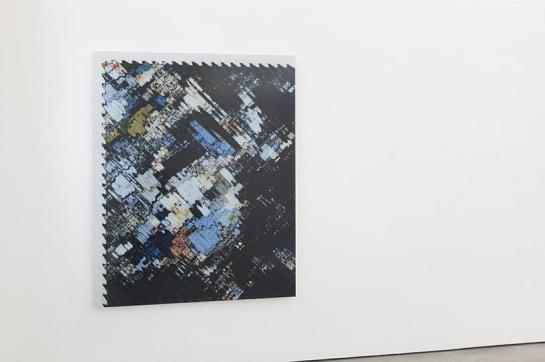
Re:post from Hyperallergic, written by Thomas Micchelli on August 16, 2014
The exhibition takes its title from a poem by Susan Howe, and its subject is aphasia, described in the gallery’s press release as “a cognitive disorder causing an inability to understand or produce speech.” The curatorial intention, drawing on concepts developed by the Russian-American linguist and scholar Roman Jakobson, is to present aphasia “as a cypher with metaphoric and metonymic implications.”
An intriguing concept: how to create an art exhibition about the inability to communicate? That is what curator Rachel Valinsky has set out to do in Itself Not So, the current group show at Lisa Cooley on the Lower East Side, and for the most part, her selections neatly vault past the inherent paradox of the proposition.
Typically (though not necessarily) caused by a stroke, aphasia ranges in severity from an inability to find the correct words for things to the complete loss of the capacity to use or comprehend language, whether spoken, written or signed. At the same time, it does not interfere with the patient’s mental faculties, which only increases the frustration of those suffering from the disorder.

The exhibition, according to the gallery statement, has assembled a selection of artworks that “taken together, form a polyphonic response to the fundamental rupture between thought and expression that aphasia engenders.”
The metaphoric implications of aphasia’s “fundamental rupture between thought and expression” can be readily applied to the creative process, where the rupture between subject and form, idea and object, can often feel unbridgeable — and yet the connection must be made if the artwork is to hold together. And so how does one develop such a concept in the context of an exhibition? The curator’s answer is evidently to present works in which deliberate omissions and obfuscations are major components, as if they are confronting us with their own unmaking.
This idea is at its most conspicuous in a work like Michael Dean’s “Analogue Series (tongue) On the pronunciation of the letter L” (2014), which features a straight-back chair with a black (aphasic?) tongue in the place of one of its four legs, rendering it unusable. In a piece by Ryan Gander, which bears the impossibly long title, “Associative Template # 23 – (And all that chatter around your career) *Debit and Credit by Dan Fox, first published in Frieze, Issue 119, Nov-Dec 2008” (2009), aphasia’s gaps in comprehension are suggested by the holes left in a large, handprinted photograph from which sizable sections have been laser-cut and placed on the floor beneath it.

The sensation of halting, unclear thoughts is visualized to striking effect in Fia Backström’s “An-alpha/pet-isms…” (2014), an installation consisting of sheets of clear vinyl film hanging from five standing steel frames, upon which letters of the alphabet float like obscured, distorted ghosts amid inky clouds, blurs and blots.
And there is “I Hate” (2007), a hi-def video by Imogen Stidworthy that focuses on a middle-aged man, presumably afflicted with aphasia, and his attempts to try and speak. All of these works walk the tightrope between clarity and unintelligibility in ways that are by turns visceral, heady, sensuous and whimsical.
The reason behind including some of the other works in the show is not as clear-cut, but that makes them no less engaging. There’s artist/musician Ben Vida’s “Slipping Control (pink/green/blue)” (2013-2014), an elegantly designed triptych comprised of three framed digital prints employing patterns of letters laid out in the spaces between pink, green and blue rectangles. The work is the basis for a vocal piece performed by the artist, whose repetitive, percussive soundings could be likened to aphasic stammering, but without the loss of control experienced by the patient.

Rick Myers’s “Either side of the eye” (2010) offers two steel squares covered in lubricating flake graphite, one featuring a concave depression and the other with a matching convex protrusion. A quick glance can fool the eye as to which is which, but such visual ambiguity doesn’t seem to touch on the communicational handicaps stemming from the disorder.
Another work by Myers, “Study with BEFORE following AFTER” (2010), more successfully conveys the idea of expression held captive. The piece couldn’t be simpler — five black, vertical bands running the length of a narrow sheet of paper — but there is something compellingly dense, even layered about it. It is tempting to think that this impression is related to the work’s materials and process, which are described on the checklist as “Alcohol sealed sooted paper with etched soundwaves of the words AFTER, BEFORE, AFTER, having been spoken aloud and transcribed using a phonautograph.”
There are two other abstractions in the show, both by James Hoff, though they look like the work of two different artists. “Concept Virus #1” (2013), in enamel on aluminum, looks like hyper-pixelated video snow, while “Stuxnet No. 5” (2014), a red, white, blue and black Chromalux transfer on aluminum, is a Gerhard Richter-like smear of color. Neither seems to fit under the exhibition’s umbrella, which is also true of a conceptual piece by Julien Bismuth called “A train of thought” (2011), consisting of four sticks painted different colors on each of their four sides. In the notes for this work we are told, “The sticks are rotated daily so as to go through all 24 permutations of the four-color sequence.” Perhaps the piece’s daily evolution is meant to correspond with the slow, frustrating grind of rehabilitative therapy?

According to its wall text, another conceptual work, Research Services’ “If You’re Phone Doesn’t Ring, It’s Me” (2014), takes the subject of aphasia “as a social phenomenon triangulated by politics, aesthetics, and technology.” The artists, soliciting phone numbers from the viewing public, plan to interview participants via “robotic avatars” and broadcast the conversations in the gallery.
The exhibition’s remaining pieces, all text-based, perhaps have the most tenuous connection to aphasia, but they point in some interesting directions. Sophia Le Fraga’s video, “W8ING” (2014), consists of scrolling cellphone text messages chockablock with abbreviations and emoticons — which, in their disuse of language, may or may not be signs of aphasia. “W8ING” is supposedly a riff on Samuel Beckett’s Waiting for Godot, at least according to Karen Rosenberg’s review in yesterday’s New York Times, but the triteness of the dialogue makes the connection murky at best. (Le Fraga’s other video, “TH3 B4LD 5OPRANO; or, English Made Easy,” 2014, apparently applies the same treatment to Eugène Ionesco, but the piece was not available the afternoon I visited the gallery.)
Both Sue Tompkins and Christopher Knowles use typewriters to create their works. Tompkins’ handsome, 18-part “The Lost Weekend” (2014) runs in a horizontal line across two sides of a corner of the room. Incorporating typewritten designs and enigmatic phrases on letter-size sheets of newsprint, the piece’s mystery-shrouded words could be considered stand-ins for the confusion over precise meanings that aphasia can cause.

Knowles, who received a diagnosis of autism when he was a child and came into prominence at the age of 17 when his poetry was included in the libretto for Philip Glass’s Einstein on the Beach(1976), has contributed two of his pattern-based, black-and-red typewriter pieces, “Designs” and “Butterfly Blocks,” both from the 1980s. At the top of “Designs,” he has repeated the words “black” and “red” in their corresponding colors. The self-evident meaning of those marks, which soon give way to complex streams and patterns of a single letter — the lowercase “c” — embodies a poignant literalism in search of human connection. There is no abstraction, no chance of a mistake: red is red and black is black, a simple truth that marks the first step in the stairwell toward a sense of surety and understanding.
The poets Susan Howe and Aram Saroyan employ their own poetry as works of art in very different, very potent ways. Howe uses another obsolete technology, letterpress, to create drifting, squeezed and fragmented shapes out of excerpts from her poems; we don’t know what to respond to first, the elegance of the designs or the music of the words (some of which are illegible). But this is an instance of neither/nor — the physical beauty of the objects creates a doubled meaning, with each element dependent upon and inseparable from the other.
Aram Saroyan, a pioneer of Minimalist poetry, is showing “Lighght” (1989), the yellow-on-white silkscreen he made from his famous (or, for some, notorious) one-word poem, “lighght,” which was first published in 1965. Like the orders of significance in the pieces by Knowles and Howe, the image in Saroyan’s print is suspended between, and compounded by, what constitutes a word and the indefinable visual resonances carried by its semiotic representation. These poets, rather than falling into the rupture between thought and expression, bring to their visual works an understanding of the limits of language and the tools — from the metrical to the symbolic to the typographic — needed to traverse them. To make art out of their poems is just another step along the continuum.
Itself Not So continues at Lisa Cooley (107 Norfolk Street, Lower East Side, Manhattan) through August 29.
 I am drawn to the work of Tatiana Trouvé, the works seem strong and made with such precise intent yet delicate and respectful of the spaces they occupy. Trouvé exhibits a skill that I rarely see with a lot of artworks and that is touch, an ability to present works that are not over worked and stand on their own, not questioning why they were made. This subtle skill allow Trouvé to present works that fulfil a hunger I guess for me as an artist to see within other artists practices. Trouvé works intrigue and raise questions of their being and a desire to ask more. I am not sure I can ask for more from art work. The review by Andrea Gyorody in Artforum discuss’s some of the work in her first solo show at the Kunstmuseum in Bonn.
I am drawn to the work of Tatiana Trouvé, the works seem strong and made with such precise intent yet delicate and respectful of the spaces they occupy. Trouvé exhibits a skill that I rarely see with a lot of artworks and that is touch, an ability to present works that are not over worked and stand on their own, not questioning why they were made. This subtle skill allow Trouvé to present works that fulfil a hunger I guess for me as an artist to see within other artists practices. Trouvé works intrigue and raise questions of their being and a desire to ask more. I am not sure I can ask for more from art work. The review by Andrea Gyorody in Artforum discuss’s some of the work in her first solo show at the Kunstmuseum in Bonn.



















































